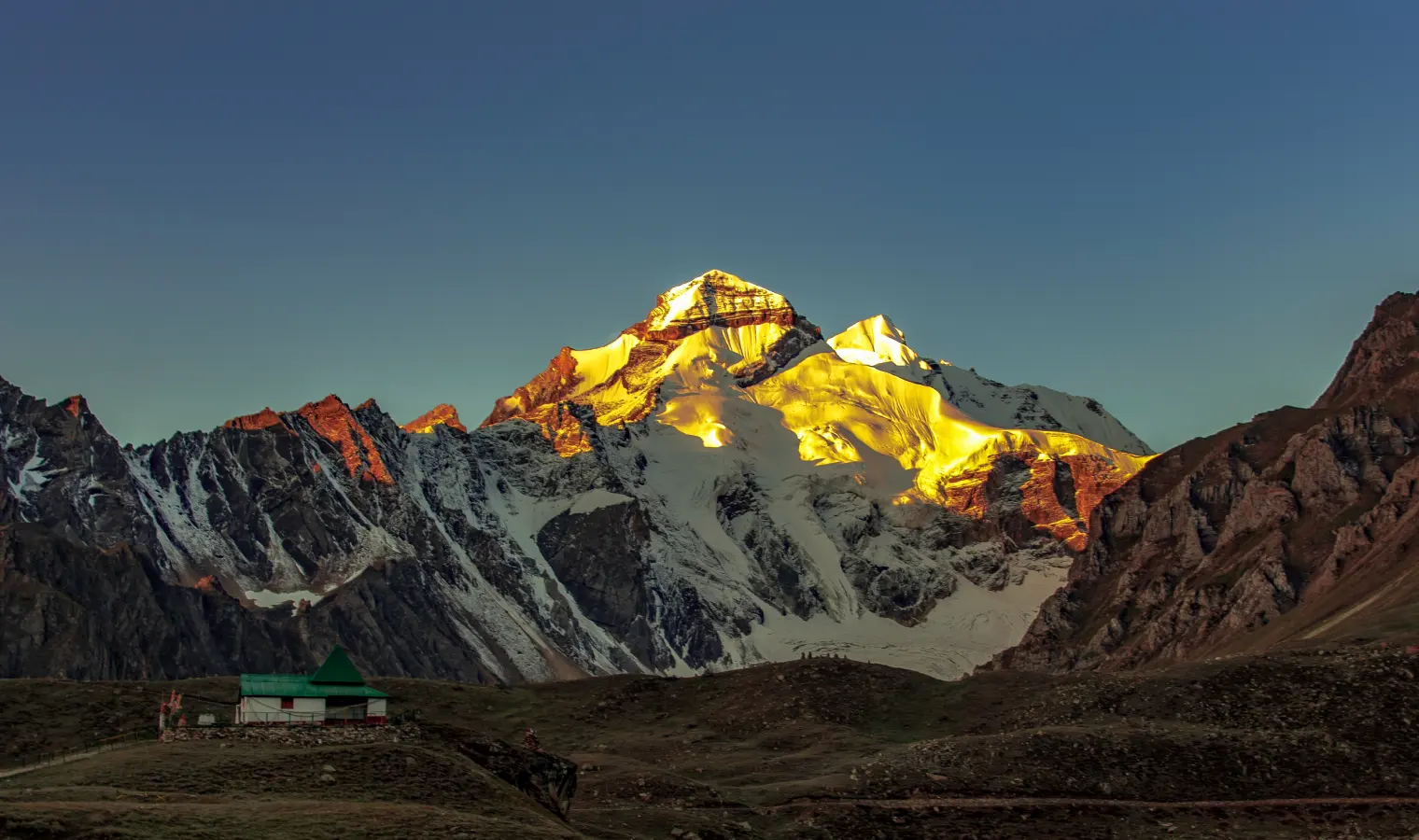Nestled in the tranquil and remote folds of the Kumaon Himalayas in Uttarakhand, the Adi Kailash and Om Parvat Yatra is one of the most spiritually enriching and visually breathtaking pilgrimages in India. Often referred to as the “Chhota Kailash” or “Little Kailash,” Adi Kailash holds a sacred status second only to Mount Kailash in Tibet. Nearby, the mystical Om Parvat, with its naturally occurring snow-formation resembling the sacred Hindu syllable “ॐ” (Om), captivates pilgrims and adventurers alike.
This yatra is not just a journey through mountains and valleys but a passage into the deep spiritual, cultural, and mythological heart of India. As you trek or drive through ancient villages, roaring rivers, dense forests, and snow-capped peaks, every turn whispers stories of divine presence and age-old traditions.
The Significance of Adi Kailash
Adi Kailash, standing tall at an elevation of 6,191 meters (20,312 ft), is believed to be the earthly home of Lord Shiva and Goddess Parvati. The region resonates with powerful energies, and according to Hindu mythology, this is where Lord Shiva resides with his divine family.
The mountain is revered as a spiritual counterpart to Mount Kailash in Tibet, which is considered the ultimate spiritual destination in Hinduism, Buddhism, Jainism, and Bon. Since reaching the original Mount Kailash involves crossing into China and enduring a much tougher route, Adi Kailash has become a vital alternative for Indian pilgrims.
Om Parvat: The Divine Symbol in Stone
Just a short distance from Adi Kailash is the enigmatic Om Parvat, a peak that bears a naturally formed snow deposition resembling the sacred Hindu symbol “ओं.” No carving or human intervention created it — this celestial symbol appears as if etched by the hands of divinity.
This miraculous formation draws thousands of spiritual seekers and believers every year. Om Parvat is not only sacred to Hindus but also considered auspicious in Buddhist traditions. It stands as a symbol of cosmic vibration, representing the universal consciousness that pervades all life.
Starting Point: Dharchula — Gateway to the Yatra
Your spiritual journey to Adi Kailash and Om Parvat begins in Dharchula, a quaint town on the banks of the Kali River, bordering Nepal. Dharchula serves as the administrative and logistical base for the yatra. The town is a beautiful blend of Indian and Nepali culture, with the river demarcating the two countries.
From here, pilgrims undergo medical checkups and obtain inner line permits (ILP), as this area lies close to the international border and is highly sensitive.
Route and Itinerary of the Yatra
There are two main ways to undertake this yatra:
By Road (Jeep / Tempo Traveler)
By Trekking (Traditional Route)
The road journey has become increasingly popular in recent years due to improved infrastructure and BRO (Border Roads Organisation) efforts.
Day-Wise Itinerary (Road Yatra Option – 10 Days)
Day 1: Kathgodam to Dharchula
Travel through picturesque towns like Almora and Pithoragarh. Reach Dharchula by evening.
Day 2: Dharchula – Gunji (via Tawaghat and Narayan Ashram)
Drive along the Kali River through rugged mountain terrain. Reach Gunji, a charming village at 3,200 meters, where the air is thin and pristine.
Day 3: Gunji – Nabi – Kuti Village
Visit Nabi, home to the Bhotiya tribe. Drive or trek to Kuti, where Mata Parvati is believed to have resided.
Day 4: Kuti to Jyolingkong (Adi Kailash Base)
A short but spiritually significant journey leads you to the base of Adi Kailash. Spend time meditating by the Parvati Sarovar, with the majestic peak in the background.
Day 5: Adi Kailash Darshan and Return to Gunji
Perform rituals, offer prayers, and soak in the spiritual atmosphere before returning to Gunji.
Day 6: Gunji to Om Parvat Viewpoint
Drive to the Lipulekh Pass route, where Om Parvat is visible in its full glory. Spend time observing and photographing this miracle of nature.
Day 7–10: Return Journey to Kathgodam via Dharchula
Spiritual and Cultural Highlights
1. Parvati Sarovar (Adi Kailash Base Camp)
The Parvati Sarovar, located near the base of Adi Kailash, is a sacred lake believed to be the bathing place of Goddess Parvati. The reflection of the Adi Kailash peak in the lake is a surreal sight.
2. Gauri Kund
Another sacred water body where devotees perform ablutions and pray for purification. The water here is icy cold yet believed to have healing properties.
3. Pandav Fort (Kuti Village)
According to local lore, the Pandavas stayed in Kuti during their exile. The village holds mythological significance and is dotted with ancient stone structures.
4. Om Parvat Viewpoint
One of the most awe-inspiring parts of the yatra, the view of Om Parvat leaves a deep spiritual impact. Devotees chant “Om Namah Shivaya” as they witness the divine inscription.
The People and Culture
The region is home to the Bhotiya tribe, who are known for their rich Tibetan-influenced culture, wool weaving, and warm hospitality. These mountain people have adapted to the harsh terrain and high altitudes with grace and resilience.
Their lifestyle, cuisine, and spiritual practices are deeply connected with the natural environment. During the yatra, interacting with locals adds a unique cultural depth to the spiritual journey.
Best Time to Visit
The ideal window for undertaking the Adi Kailash and Om Parvat Yatra is from May to October, with June to September being the most favorable months due to relatively stable weather conditions.
Avoid the monsoon peak and winter months, as heavy rains and snow can make the journey dangerous and inaccessible.
Permits and Formalities
Since the yatra is conducted in a border-sensitive area, every traveler must obtain an Inner Line Permit (ILP) from the SDM office in Dharchula. This requires valid government ID, passport-size photos, and sometimes a fitness certificate.
Organized tours usually handle these formalities, making it easier for pilgrims.
Travel Tips for Pilgrims
Acclimatize well: Altitudes above 3,000 meters can cause altitude sickness. Spend time adjusting, drink plenty of fluids, and avoid alcohol.
Pack wisely: Include warm clothing, rain gear, sturdy walking shoes, sunscreen, medicines, and basic toiletries.
Stay connected: Mobile connectivity is patchy beyond Dharchula. Inform family before heading into remote areas.
Respect local customs: Be courteous to villagers and respect religious sites. Photography may be restricted in certain zones.
Travel in groups: Due to the remoteness and potential for emergencies, group travel is safer.
Eco-Conscious Travel
The Himalayas are fragile, both ecologically and spiritually. As a pilgrim, it’s essential to:
Carry back all trash
Avoid single-use plastics
Use biodegradable products
Support local businesses and homestays
Responsible travel ensures that this sacred region remains pristine for generations to come.
Conclusion: A Journey of the Soul
The Adi Kailash and Om Parvat Yatra is more than a pilgrimage; it is a soulful expedition into the Himalayas where divinity meets nature. Whether you’re seeking spiritual awakening, inner peace, or just the awe of Himalayan majesty, this yatra has something to offer.
As you stand before Om Parvat or sit in meditation by Parvati Sarovar, you realize that this journey is not about reaching a destination — it’s about returning to yourself. The echo of “Om Namah Shivaya” in the mountain winds becomes your mantra, your guide, and your blessing.

